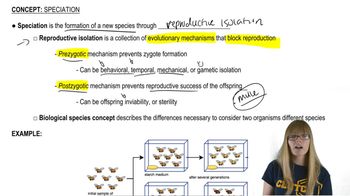In Kornberg's initial experiments, it was rumored that he grew E. coli in Anheuser-Busch beer vats. (Kornberg was working at Washington University in St. Louis.) Why do you think this might have been helpful to the experiment?
Table of contents
- 1. Introduction to Genetics51m
- 2. Mendel's Laws of Inheritance3h 37m
- 3. Extensions to Mendelian Inheritance2h 41m
- 4. Genetic Mapping and Linkage2h 28m
- 5. Genetics of Bacteria and Viruses1h 21m
- 6. Chromosomal Variation1h 48m
- 7. DNA and Chromosome Structure56m
- 8. DNA Replication1h 10m
- 9. Mitosis and Meiosis1h 34m
- 10. Transcription1h 0m
- 11. Translation58m
- 12. Gene Regulation in Prokaryotes1h 19m
- 13. Gene Regulation in Eukaryotes44m
- 14. Genetic Control of Development44m
- 15. Genomes and Genomics1h 50m
- 16. Transposable Elements47m
- 17. Mutation, Repair, and Recombination1h 6m
- 18. Molecular Genetic Tools19m
- 19. Cancer Genetics29m
- 20. Quantitative Genetics1h 26m
- 21. Population Genetics50m
- 22. Evolutionary Genetics29m
8. DNA Replication
Overview of DNA Replication
Problem 10
Textbook Question
Kornberg showed that nucleotides are added to the 3' end of each growing DNA strand. In what way does an exposed 3'-OH group participate in strand elongation?
 Verified step by step guidance
Verified step by step guidance1
Understand the context: DNA polymerase is the enzyme responsible for adding nucleotides to a growing DNA strand during replication. It requires a free 3'-OH group to initiate the addition of new nucleotides.
Recall the chemical mechanism: The exposed 3'-OH group on the sugar of the last nucleotide in the growing strand acts as a nucleophile. This means it donates a pair of electrons to form a new bond.
Identify the incoming nucleotide: The incoming nucleotide is a deoxynucleoside triphosphate (dNTP), which contains three phosphate groups. The bond formation involves the alpha phosphate of the dNTP.
Describe the reaction: The 3'-OH group attacks the alpha phosphate of the incoming dNTP, leading to the formation of a phosphodiester bond. This reaction releases pyrophosphate (two phosphate groups) as a byproduct.
Conclude the process: The result is the elongation of the DNA strand by one nucleotide, with the new nucleotide now covalently linked to the growing strand via a phosphodiester bond. This process repeats as additional nucleotides are added to the 3' end.
 Verified video answer for a similar problem:
Verified video answer for a similar problem:This video solution was recommended by our tutors as helpful for the problem above
Video duration:
2mPlay a video:
Was this helpful?
Key Concepts
Here are the essential concepts you must grasp in order to answer the question correctly.
DNA Structure
DNA is a double helix composed of nucleotides, each containing a phosphate group, a sugar (deoxyribose), and a nitrogenous base. The strands run antiparallel, meaning one strand runs 5' to 3' while the other runs 3' to 5'. This orientation is crucial for understanding how nucleotides are added during DNA replication.
Recommended video:
Guided course

DNA Structure
3'-OH Group
The 3'-OH group is a hydroxyl group attached to the third carbon of the sugar in a nucleotide. This group is essential for DNA strand elongation because it serves as the attachment point for the incoming nucleotide's phosphate group, facilitating the formation of a phosphodiester bond and allowing the DNA strand to grow in the 5' to 3' direction.
Recommended video:
Guided course

Speciation
DNA Polymerase Function
DNA polymerase is the enzyme responsible for synthesizing new DNA strands by adding nucleotides to the growing chain. It requires a template strand and a free 3'-OH group to initiate the addition of nucleotides. The enzyme catalyzes the formation of phosphodiester bonds, linking nucleotides together and ensuring accurate replication of the genetic material.
Recommended video:
Guided course

Functional Genomics
Related Videos
Related Practice
Textbook Question
475
views


